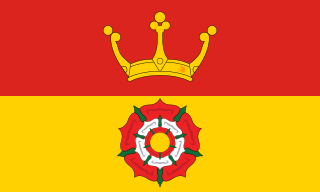
Hampshire is a ceremonial and non-metropolitan county in western South East England on the coast of the English Channel. Home to approximately 1.9 million people, Hampshire is the 5th-most populous county in England. Its largest settlements are the cities of Southampton and Portsmouth. The county town is Winchester. It is bordered by Berkshire to the north, Surrey to the north-east, Wiltshire to the north-west, West Sussex to the south-east, and Dorset to the south-west. The county contains two national parks: the New Forest and part of the South Downs, which together cover 45 per cent of Hampshire.

The Isle of Wight is an island in the English Channel, two to five miles off the coast of Hampshire, across the Solent. It is the largest and second-most populous island in England. Referred to as 'The Island' by residents, the Isle of Wight has resorts that have been popular holiday destinations since Victorian times. It is known for its mild climate, coastal scenery, and verdant landscape of fields, downland, and chines. The island is historically part of Hampshire and is designated a UNESCO Biosphere Reserve.
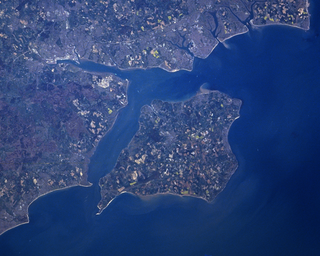
The Solent is a strait between the Isle of Wight and mainland Great Britain. It is about 20 miles long and varies in width between 2+1⁄2 and 5 mi, although the Hurst Spit which projects 1+1⁄2 mi (2.4 km) into the Solent narrows the sea crossing between Hurst Castle and Colwell Bay to just over 1 mi (1.6 km).

The River Hamble is located in south Hampshire, England. It rises near Bishop's Waltham and flows for 10.1 km (6.3 mi) through Botley, Bursledon, and Lower Swanwick before entering Southampton Water between Hamble Common and Warsash.
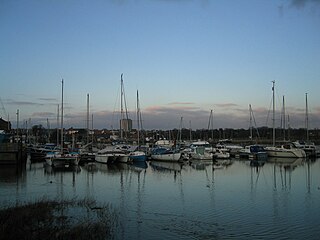
Fareham is a market town at the north-west tip of Portsmouth Harbour, between the cities of Portsmouth and Southampton in south east Hampshire, England. It gives its name to the Borough of Fareham. It was historically an important manufacturer of bricks, used to build the Royal Albert Hall, and grower of strawberries and other seasonal fruits. Current employers include Fareham Shopping Centre, small-scale manufacturers, HMS Collingwood and the Defence Science and Technology Laboratory.

Gosport is a town and non-metropolitan borough on the south coast of Hampshire, South East England. At the 2021 Census, its population was 81,952. Gosport is situated on a peninsula on the western side of Portsmouth Harbour, opposite the city of Portsmouth, to which it is linked by the Gosport Ferry. Gosport lies south-east of Fareham, to which it is linked by a Bus Rapid Transit route and the A32. Until the last quarter of the 20th century, Gosport was a major naval town associated with the defence and supply infrastructure of His Majesty's Naval Base (HMNB) Portsmouth. As such over the years extensive fortifications were created.

Solent University is a public university based in Southampton, United Kingdom. It has approximately 10,500 students (2019/20). Its main campus is located on East Park Terrace near the city centre and the maritime hub of Southampton.
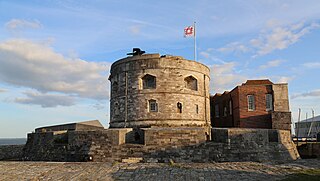
Calshot Castle is an artillery fort constructed by Henry VIII on the Calshot Spit, Hampshire, England, between 1539 and 1540. It formed part of the King's Device programme to protect against invasion from France and the Holy Roman Empire and defend Southampton Water as it met the Solent. The castle had a keep at its centre, surrounded by a curtain wall and a moat. Initially heavily armed, it had a garrison of 16 men and as many as 36 artillery guns. The castle continued in use for many years, surviving the English Civil War intact and being extensively modernised in the 1770s. During the 19th century, Calshot Castle was used by the coastguard as a base for combating smuggling. In 1894, however, fresh fears of a French invasion led to it being brought back into use as an artillery fort: a large coastal battery was constructed alongside the older castle and a boom built across Southampton Water, controlled from the castle.

Hampshire is a county in Southern England with some notable archaeology and many notable historic buildings.

West End is a parish in Hampshire in the borough of Eastleigh, five miles (8.0 km) east of the city of Southampton. The village of West End is small and generally classed as an area in the outer suburbs or rural urban fringe of the borough of Eastleigh because of the surrounding woodland and countryside, including Telegraph Woods and Itchen Valley Country Park.
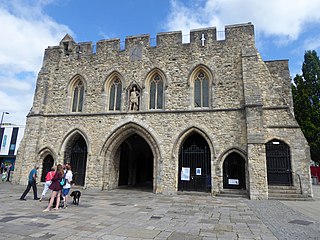
Southampton is a port city in the ceremonial county of Hampshire in southern England. It is located approximately 70 mi (110 km) south-west of London and 15 mi (24 km) west of Portsmouth. The city forms part of the South Hampshire built-up area, which also covers Portsmouth and the towns of Havant, Waterlooville, Eastleigh, Fareham and Gosport.

BBC South is the BBC English Region serving Oxfordshire, Hampshire, Isle of Wight, Dorset, Berkshire and parts of Gloucestershire, Buckinghamshire, Northamptonshire, Surrey, West Sussex and Wiltshire, with geographic coverage varying between digital, television and radio services.

The Bargate is a Grade I listed medieval gatehouse in the city centre of Southampton, England. Constructed in Norman times as part of the Southampton town walls, it was the main gateway to the city. The building is a scheduled monument, which has served as a temporary exhibition and event space for Southampton Solent University since 2012.
Southampton is a city in Hampshire, England. The area has been settled since the Stone Age. Its history has been affected by its geographical location, on a major estuary on the English Channel coast with an unusual double high-tide, and by its proximity to Winchester and London; the ancient and modern capitals of England. Having been an important regional centre for centuries, Southampton was awarded city status by Queen Elizabeth II in 1964 .

River Hamble Country Park is a 144.1-hectare (356-acre) Local Nature Reserve which runs along the west bank of the River Hamble between the villages of Botley and Bursledon in Hampshire. It is owned by Hampshire County Council and managed by Hampshire Countryside Service. It is part of Solent and Southampton Water Ramsar site and Special Protection Area, and of Solent Maritime Special Area of Conservation. Part of it is in Upper Hamble Estuary and Woods, which is a Site of Special Scientific Interest.

Solent Sky is an aviation museum in Southampton, Hampshire, previously known as Southampton Hall of Aviation.

Squadron Leader Edwin Rowland Moon DSO* was an English aviation pioneer who served in the Royal Naval Air Service and Royal Air Force during the First World War. He was a prisoner of war and he was twice awarded a DSO.

The Port of Southampton is a major passenger and cargo port located in the central part of the south coast of England. It has been an important port since the Roman occupation of Britain nearly two thousand years ago, and has a multifaceted history. From the Middle Ages to the end of the 20th century, it was a centre for naval shipbuilding and a departure point for soldiers going to war. The port also played a role in the development of hovercraft, flying boat services, seaplanes and the Spitfire fighter plane. Before the advent of jet travel, Southampton was Britain's gateway to the world. The port also played a minor role in the history of Britain's canals.

The SeaCity Museum is a museum in Southampton, England, which opened on 10 April 2012 to mark the centenary of RMS Titanic's departure from the city. It is housed within a part of the Grade II* listed civic centre building which previously housed the magistrates' court and police station. The museum contains two permanent exhibitions, one dedicated to Southampton's connection with RMS Titanic, and the other to the city's role as gateway to the world. A third space for temporary exhibitions is housed in a purpose-built pavilion extension to the civic centre. Further phases of development may yet add to the exhibition space.
The following is a timeline of the history of the city of Southampton, Hampshire, England.




















